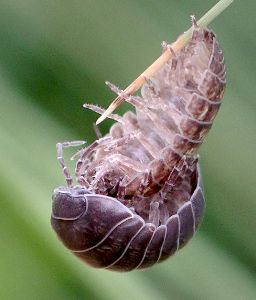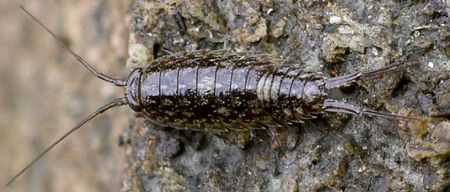
Fairy Shrimp
 Fairy Shrimp |
When I was a kid in Illinois, I loved to find the little crustaceans in the early spring. I'd sometimes put them in an aquarium and watch them float dreamily back and forth, their numerous legs propelling them in a graceful rhythmic pattern. If I put any other critters in with them, though, the fairy shrimp were soon history. Water beetle larvae, baby crayfish, dragonfly nymphs, and seemingly harmless water mites and scud inevitably attacked and ate them.
 Clam Shrimp |
There were large, colorful advertisements in comic books back in the '60s for Sea-Monkeys. As a typical child of that decade, I read plenty of comic books and saw the enticing ads for almost human-looking creatures that could be mail-ordered for about $1, lived in an aquarium and were reported to be trainable. My mother quenched my gullible excitement by explaining that the animals were really just brine shrimp, the salt-water equivalent of fairy shrimp, and that they were as different from the ads' drawings as the super heroes and gruesome monsters were from real people. Once I read about brine shrimp in a biology book, I finally accepted her decision NOT to waste money on brine shrimp eggs and fancy packaging. Besides, we could get fairy shrimp for free.
The crustaceans that I kept in my aquarium ranged in size from the nearly microscopic Cyclops to large crayfish that invariably managed to crawl out and expire in a secluded, far too dry, corner of our house. Cyclops are minuscule copepods that scoot around with jerky motions. The females trail pairs of egg sacs on either side of their tail. They often resided on the glass sides of the aquarium where they were easily observed. Another tiny denizen of our fish tanks was the water flea, or Daphnia. These didn't cling to the glass but swam around freely. The fish usually ate all they could catch and only a few that stuck close to the gravel at the bottom survived for any length of time.
 Pillbugs mating |
Two other kinds of crustaceans were frequent residents in my aquariums. Scud are small amphipods that swim quickly and usually tend to hide amid the leaves of pond plants. Whenever they are taken out of the water, then dropped back in, they tend to get caught on the surface tension and cannot get back underwater without help. If a pond becomes uninhabitable or dries up, the scud will leave and seek new digs. They can hop a bit, but they are rather ungainly on land and must find water before they dry up and die. Like all the other crustaceans I've observed, they turn red when they are cooked. In the north, streams that hosted scud often also contained isopods. These relatives of pillbugs and sowbugs crawl around on the bottom just like their terrestrial cousins. They seem to need more dissolved oxygen than most other crustaceans, and I was never very successful at keeping them alive in an aquarium for long.
Though not as common as their comparative saltwater relatives, shrimp and prawns do inhabit some pristine freshwater streams. The San Marcos River just south of Austin contains small, almost colorless shrimp that look just like the tiny glass shrimp found in coastal waters. They made nice aquarium pets, helping keep the bottom of the tank clean. Freshwater prawns, on the other hand, are rare but big enough to be table fare. I once found the molted exoskeleton of a freshwater prawn in Juniper Creek in Florida. It was over 6 inches long!
 Rock Slater |
When I lead entomology hikes or give talks on the subject, I frequently ask participants if sowbugs and pillbugs, sometimes called roly-polies or woodlice, are insects. The answers are generally a confident "don't know" because they perceptively suspect this is a trick question. People are then surprised to find out that these very common little animals are crustaceans, but this is one of those interesting factoids that tend to stick in the brain. Like aquatic crustaceans, sowbugs and pillbugs have gills, but they are encased in a waterproof chamber. If submerged, these relatives of shrimp, crab and lobsters will drown.
Unlike insects, crustaceans have colonized both fresh and saltwater habitats. It's obvious that the sowbugs found in forest litter and compost bins are quite similar to the slaters (also called sea roaches or rock lice) found on pilings, walls, and rocks near the ocean. There is also a saltwater equivalent of the scud found in freshwater ponds,
 Skeleton Shrimp |
A group of crustaceans that everyone has seen but few realize their true identity are the barnacles. Rock, leaf, volcano, acorn, and gooseneck are just some of the names of this diverse taxon. While their outer hard shells are usually seen, especially when stepped upon with bare feet, they are only active when underwater, so they don't even look alive during low tides when they are exposed or when their substrate washes up on the beach. View them in a tide pool, or place some in a cup of water, and they almost at once begin to repeatedly reach and withdraw their legs, an action that strains for small particles of food.
One very odd little animal that I once found washed up in algae was a skeleton shrimp. This tiny, elongate creature doesn't actually resemble much of anything in the Animal Kingdom, but it does resemble a bit of algae, especially when it strikes its characteristic plant-like pose.
I do have a special fondness for crustaceans, and it's not just because I like the taste of crab and shrimp. Some of the species are so strange that they look like aliens or imaginary beasts. It's nice that such fascinatingly bizarre beings can be found in relatively mundane places, like puddles, seashore detritus, creeks, and our compost bin.